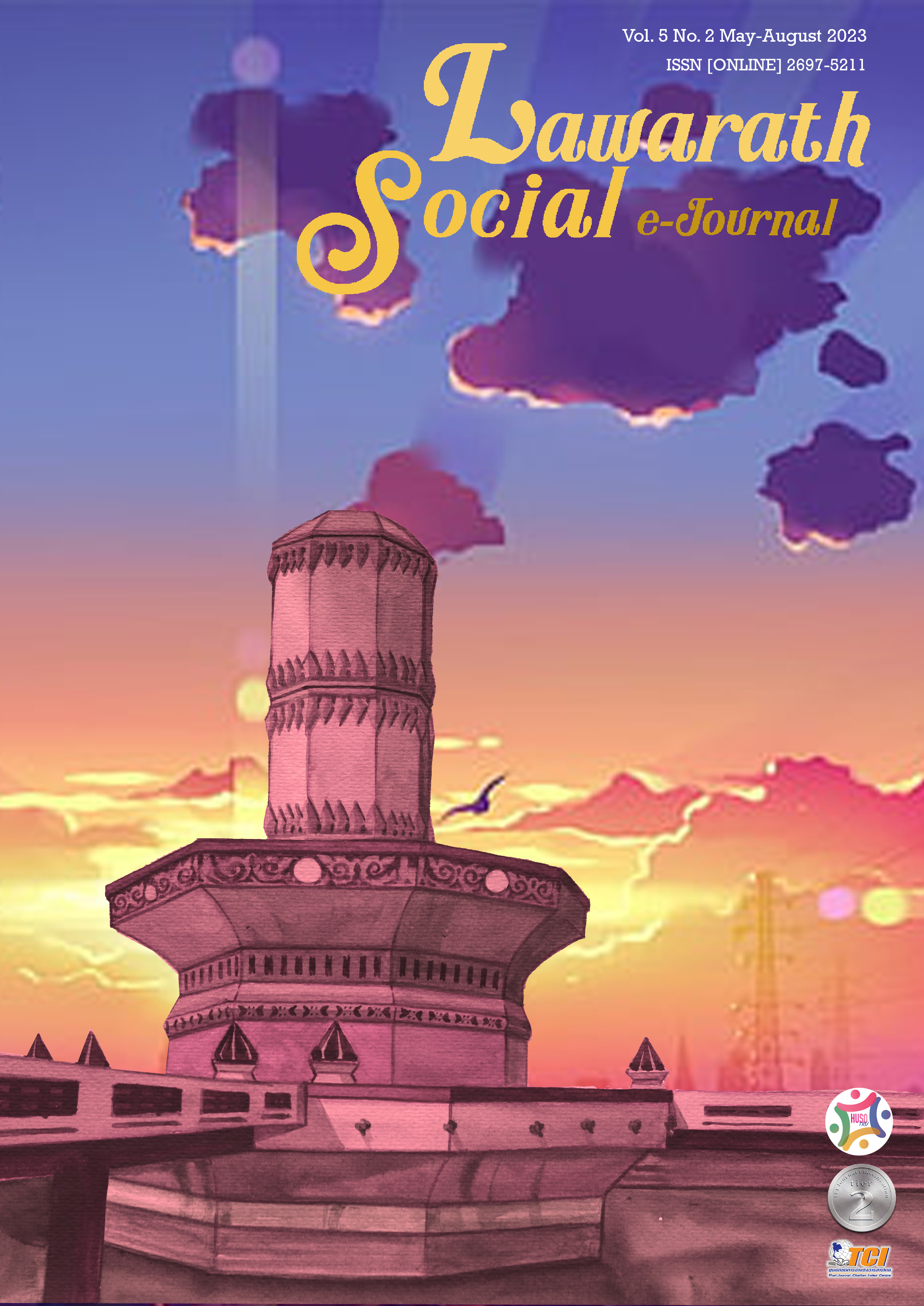การขัดเกลาทางสังคมด้านจิตใจในการ์ตูนสั้นจีน เรื่อง เณรน้อยอี้ฌาน
คำสำคัญ:
การขัดเกลาทางสังคม, จิตใจ, การ์ตูนสั้นจีน, เณรน้อยอี้ฌานบทคัดย่อ
งานวิจัยนี้ มีวัตถุประสงค์เพื่อศึกษาการขัดเกลาทางสังคมด้านจิตใจในสังคมจีนผ่านการ์ตูนสั้นจีน เรื่องเณรน้อยอี้ฌาน《一禅小和尚》ที่แพร่ภาพออกอากาศทางเวยป๋อ (Weibo) ระหว่างวันที่ 1 มกราคม พ.ศ. 2560 – 1 มกราคม พ.ศ. 2563 จำนวนทั้งสิ้น 197 ตอน โดยใช้ระเบียบวิธีวิจัยเชิงคุณภาพ คือ การจัดกลุ่มตามประเภทของเนื้อหาสาระ เก็บรวบรวมข้อมูลเชิงสถิติและวิเคราะห์เนื้อหา (Content Analysis) ซึ่งผลการวิจัยพบว่า การขัดเกลาทางสังคมด้านจิตใจในการ์ตูนสั้นจีน เรื่องเณรน้อยอี้ฌาน แบ่งออกเป็น 5 ประเภท ได้แก่ 1. ศีลธรรมจรรยา 2. ขนบธรรมเนียม/ประเพณี 3. ความเชื่อ/ศาสนา 4. ทัศนคติ/ความคิดเห็น และ 5. แรงบันดาลใจ จากเกณฑ์การนับประเภทเนื้อหาที่ปรากฎเป็นจำนวนครั้งในแต่ละตอน ประเภททัศนคติ/ความคิดเห็นปรากฏมากที่สุด คิดเป็นร้อยละ 70.89 ประกอบด้วย 6 ประเด็นย่อย คือ ทัศนคติ/ความคิดเห็นเกี่ยวกับการเติบโตเป็นผู้ใหญ่ ความรัก การใช้ชีวิต ความสัมพันธ์ระหว่างบุคคล บุคลิกภาพส่วนบุคคล และอารมณ์/ความรู้สึก ซึ่งตอบสนองต่อลักษณะทางด้านจิตใจ (จิตลักษณะ) และสะท้อนถึงความต้องการทางด้านจิตใจของชาวจีนในปัจจุบัน โดยกระตุ้นให้ผู้ชมชาวจีนย้อนมองชีวิตของตนเอง อีกทั้งยังสามารถให้คำแนะนำที่เป็นประโยชน์ในการใช้ชีวิตแก่ผู้ชมอีกด้วย ส่วนประเภทขนบธรรมเนียม/ประเพณีปรากฏน้อยที่สุด
Downloads
เอกสารอ้างอิง
คณะอนุกรรมการพิจารณาเกณฑ์การถอดเสียงภาษาจีนเป็นภาษาไทย สำนักเลขาธิการนายกรัฐมนตรี. (2543). เกณฑ์การถอดเสียงภาษาจีนแมนดารินด้วยอักขรวิธีไทย. ปทุมธานี: โรงพิมพ์มหาวิทยาลัยธรรมศาสตร์.
จุฑามาส ศรีโมรา. (2545). การวิเคราะห์เนื้อหาภาพยนตร์การ์ตูนของไทยทางโทรทัศน์ในด้านการขัดเกลาทางสังคม. วิทยานิพนธ์ปริญญามหาบัณฑิต จุฬาลงกรณ์มหาวิทยาลัย.
ศศิธร อภิสิทธิ์นิรันดร์. (2541). การขัดเกลาทางสังคมผ่านรายการโทรทัศน์สำหรับเด็กประเภทรายการปกิณกะบันเทิง. วิทยานิพนธ์ปริญญามหาบัณฑิต จุฬาลงกรณ์มหาวิทยาลัย.
อติชาติ คำพวง. (2563, มกราคม-เมษายน). คติด้านความกตัญญู (孝) ในวัฒนธรรมจีน: ภาพสะท้อนจริยศาสตร์ครอบครัวจีนผ่านสำนวน. มนุษยศาสตร์สาร, 21(1), 137-157.
อุทัย หิรัญโต. (2526). สารานุกรมศัพท์สังคมวิทยา-มานุษยวิทยา. กรุงเทพฯ: โอเดียนสโตร์.
Fan, C., F., &Wang, L., Y. (2009, February). The Forgetting Logic of Chinese Society Viewed from the Myth of Meng Po Soup. Folk Culture Forum, 6(1), 34-38.
Geng, X. F. (2013, October). Analysis of Contemporary Chinese Way of Life and Psychological Characteristics. The Border Economy and Culture, 10(10), 113-115.
Jin, J. (2014). Animation Short Film Creation. Beijing: China Architecture & Building Press.
Li, Y. (2019). Ten million fans, Top Ten of Tiktok, Little Monk Yichan How to Cultivate. Retrieved December 4, 2022, from http://k.sina.com.cn/article_6090508679_16b05c98701900kcks.html#/.
Lin, M. (2019, November). The Pressure and Anxiety of Contemporary Young Chinese. People's Tribune, 33(33), 78-80.
Little Monk Yichan. (2017). Goodwill. Retrieved December 4, 2022, from https://video.weibo.com/show?fid=1034:3956feb97990fe98f2e064b9107b95ae.
______. (2017). The Mid-Autumn Festival. Retrieved December 4, 2022, from https://video.weibo.com/show?fid=1034:a733bee492273eb9ec904b9ab4309cfa.
Muo, C. (2015, September). On the Cultural Interpretation of the Chinese Story “Matchmaker Deity”. Journal of Guangxi Teachers Education University (Philosophy and Social Sciences Edition), 36(5), 18-20.
Tu, X. Z. (2008). Making Animation Short Film. Changsha: Hunan Normal University Press.
Wu, J. Z. (2018, July). “Yichan in Suzhou”, the Backstory of Getting 100 Million Likes. Modern Suzhou, 9(14), 16-17.
Xie, Q. X. (2020). The Study on the Transmutation of Contemporary Aesthetics Reflected in Short Videos. Master’s thesis, Shandong University.
Xu, C. M. (2007). Where the Anxiety among Young Chinese Comes from. Retrieved December 4, 2022, from http://zqb.cyol.com/content/2006-11/30/content_1592726.htm.
You, W. B. (2008, February). Comparison of Fate Ethics among Chinese Philosophies of Confucianism, Taoism, and Buddhis. Chinese Medical Ethics, 21(1), 116-125.
ดาวน์โหลด
เผยแพร่แล้ว
รูปแบบการอ้างอิง
ฉบับ
ประเภทบทความ
สัญญาอนุญาต

อนุญาตภายใต้เงื่อนไข Creative Commons Attribution-NonCommercial-NoDerivatives 4.0 International License.



